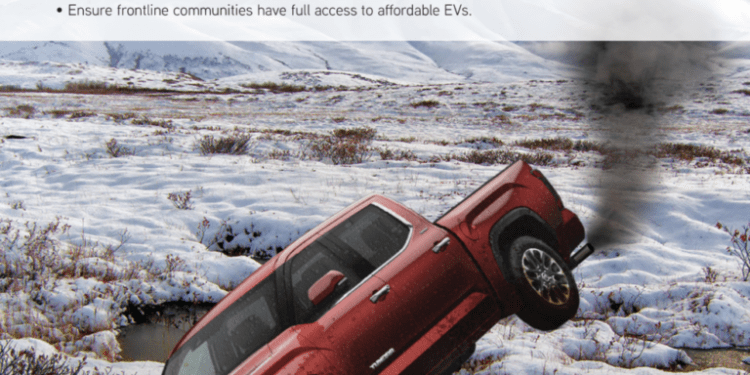Today, the Center for Biological Diversity and Green Latinos placed a full-page ad in The New York Times calling on President Biden to take action on clean vehicles. The ad castigates automakers for naming their gas-guzzling SUVs and pickups after natural landscapes, and calls for the President to set standards that dramatically boost electric vehicle (EV) production and require automakers to slash the pollution caused by new gas-burning vehicles.
The ad follows an online video campaign created by the groups and shared widely on social media in recent weeks. It features an image of a Toyota Tundra nose-down in melting tundra, and calls on Biden to direct the EPA to write new rules that would slash auto pollution 75% by 2030. This would be achieved by rapidly increasing EV production and cutting pollution from new gas-powered cars and trucks, closing all loopholes that help automakers make more gas guzzlers, and ensuring frontline communities have full access to affordable EVs.
The Environmental Protection Agency is due to propose new rules in the coming weeks that will likely set auto standards through at least 2030. EVs and other clean technology they’ve already developed can help carmakers reach the 75% target. Last year California adopted a regulation to achieve 100% zero-emission new car sales by 2035, and that rule has already been adopted by several other states.
The Center for Biological Diversity is a national, nonprofit conservation organization with more than 1.7 million members and online activists dedicated to the protection of endangered species and wild places. Dan Becker, director of the Center’s Safe Climate Transport Campaign, said “While automakers talk out of both sides of their tailpipes, President Biden can take action to usher out the era of climate-destroying cars and trucks. The president needs to set standards that dramatically boost EV production and require automakers to slash the pollution caused by new gas-burning vehicles in the meantime. Cutting auto pollution by 75% by 2030 is the biggest single step America can take to prevent catastrophic global warming.”
Amanda Pantoja, a sustainable communities program consultant with GreenLatinos, added “Our communities need clean air, not more toxic auto pollution. Setting the highest clean car standards is essential to achieving environmental justice for low-income communities of color disproportionately impacted by vehicle emissions. President Biden must deliver on his commitment to advance zero-emission transportation and ensure that vulnerable populations have access to clean vehicles in their neighborhoods.”
The Center for Biological Diversity and Green Latinos are calling on President Biden to take action on clean vehicles and ensure that vulnerable populations have access to clean transportation. The ad in The New York Times is just one way they are raising awareness of this important issue, and urging the President to set strong emissions standards that will help protect our environment and communities from the effects of climate change.
FAQ
Q1. How electric car chargers work?
A1. Electric car chargers work by connecting to an electrical outlet and providing power to the car’s battery. The charger then converts the electricity into a form that the car’s battery can use.
Q2. What electric car has the longest range?
A2. The Tesla Model S has the longest range of any electric car currently on the market, with a range of up to 370 miles on a single charge.
Q3. How electric car batteries are recycled?
A3. Electric car batteries are recycled by breaking them down into their component parts and then separating out the metals, plastics, and other materials for reuse. The metals are melted down and reused in new products, while the plastics and other materials are recycled into new products.





